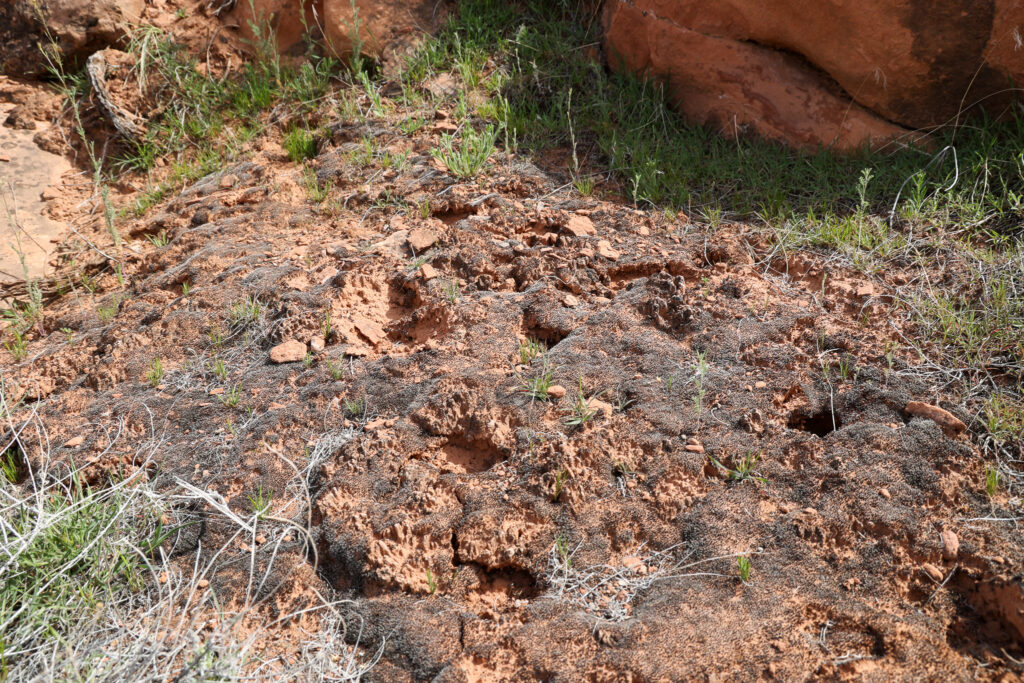(Photo Credit: Kaya Lindsay)
Sometimes also known as Cryptobiotic Soils
If you’ve ever been on a hike in Moab chances are you’ve seen the crusty black growths that cover some areas of the soil. This small collection of mossy plant life looks kind of like the top of an extremely toasted marshmallow.
You may be asking yourself, what is that stuff? It looks kind of gross. And, why should I care about it?
Well, to be brief, it is part of the life force that keeps the Moab ecosystem thriving. And you should care about it because it’s really really cool!
I’ll go into each part of this in greater detail below.
What is it?
To kick us off, what is it? The biological soil crusts, or biocrusts, sometimes called cryptobiotic soils are simply a network of cyanobacteria that create a mesh-like structure on the surface of the sand. Cyanobacteria are some of the oldest life forms on earth! These webs of cyanobacteria create a crusty mesh-like structure on the top of the soil, which then becomes host to heaps of other very tiny lifeforms. If you spend time looking at biological soil crusts, (which you should, it’s extremely cool to look at) you will see all sorts of colorful lichens, mosses, tiny flowers, and grasses that put their roots into the biological soil crusts.
It is fascinating to get down on the ground and peer into a small patch of cryptobiotic soils. You can see entire ecosystems on a micro level!
What does it look like?

(Photo Credit: Kaya Lindsay)
Biological soil crusts are primarily a black “crust” that appears on the top of the sandy red soil so commonly found in Moab. As you can see in the picture above, there are sprouts of green coming up through the biocrust, and if you look closely you can see hints of white as well.
In my time in Moab I have seen black, white, green, orange, yellow, and blue patches of biological soil crusts! The biocrust is a hodge podge of different microorganisms, so you will get a beautiful variety wherever you look.
The primary distinguishing feature however, is the crunchy crust like substance, about 2-5 inches deep. This patch of biocrust unfortunately was stepped on, and part of it has been destroyed. You can see the red soil peeking through beneath the biocrust. It’s not very thick, and it takes quite a long time to grow!
Where does it grow?

(Photo Credit: Kaya Lindsay)
Bio crusts grow in almost all soils. However, in dry climates with higher clay contents in the soils, the biocrusts become more abundant. There is a really excellent and extremely in depth field guide to biocrusts that USGS recommends for anyone who is interested in learning more about the exact places and types of biocrusts there are. You can check out the field guide here.
Why does it matter?
The most important question! Why does it matter? Why should you care about these micro bacteria and lichens that seem to plague the Utah landscape? You should care because they are extremely important to the ecosystem in Moab!
These little cyanobacterias help stabilize the soil and prevent erosion from the torrential wind and rains we get in Moab. They also provide places for planlife to grow their roots and thrive. All of the bushes and trees you see in Moab utilize the biocrusts network of living organisms to secure their roots and gather essential nutrients. The plants and bushes support the local bugs, lizards, and small mammals, which in turn support the larger animals like Coyotes, Mountain Lions, Bobcats, and even bears. The tiny yet steadfast life of biological crusts are crucial to the environment out here.
The sandy soil in the Moab area is fairly nutrient deficient. Not much can grow here without help. If you look at any trail in Moab you can see the stark difference between the trail your feet are on and the grassy environments around you.
How you can help

(Photo Credit: Kaya Lindsay)
You can help by staying on trail and letting your friends and family know about the delicate nature of these crusts! It is much better for the desert if you stick to slick rock trails, where there are no biocrusts, or if you stay on trail as best you can. These tiny crusts take decades to grow and a single misstep can crunch them out of existence for good.

We have several guided hikes listed on our website which we highly recommend! However, if you do take the time to explore the Moab area, please be aware of yourself, small children, dogs, and especially the places you park your car!
Without the biocrusts Moab would likely be a barren sandy desert, instead of the beautiful arid environment we have. When recreating in Moab, no matter if you’re a hiker, climber, mountain biker, jeeper, or BASE jumper, please respect the biocrusts. And if you haven’t yet, get down to the bio crusts level and just take a look at some, it is really beautiful and very neat!
(Photo Credit: Kaya Lindsay)







Leave A Comment